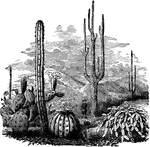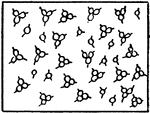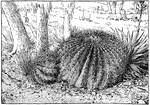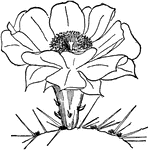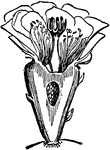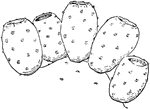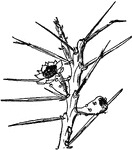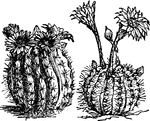
Cacti
These plants have adapted to continuous drought and are able to retain great amounts of water. These…
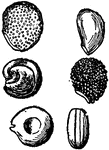
Seeds of Cacti
Illustrated are seeds of cacti. The seeds are (1) mamillaria, (2) cereus, (3) flat-jointed opuntias,…
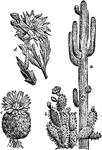
Various Cacti
Various species of cacti. a, Saguaro (Cereus giganteus); b, Paddle Cactus (Opuntia coccinellifera);…

Cactus Plants
A genus of exogenous plants containing several hundred varieties, all but one species being native to…
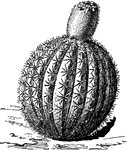
Cactus Melocactus
Cactus melocactus has ten to twenty ribs. It has a round shape and grows eight inches tall. The flowers…

Cactus Spines
The cactus spines are not connected with the axis of the stem or branches. The spines emerge from the…
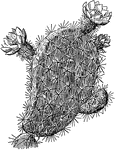
Prickly Pear
The prickly pear or Indian fig is a cactus that grows in the southwestern part of the United States.

Prickly Pear Cactus
"Called the Indian fig. The opuntia is a fleshly and succulent plant, destitute of leaves, covered with…

The Starfish Cactus
"Flowers often grow out of the cacti in a very unexpected fashion and of very curious forms. We give…

Cephalocereus Fruit
The flower envelope crowns the ovary and sometimes persists after withering on the apex of the fruit…

Cochineal
An illustration of Cochineal living on cactus. Cochineal is the name of both crimson or carmine dye…
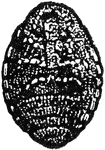
Cochineal (Female)
An illustration of a female Cochineal. Cochineal is the name of both crimson or carmine dye and the…
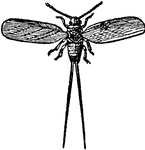
Cochineal (Male)
An illustration of a male Cochineal. Cochineal is the name of both crimson or carmine dye and the cochineal…
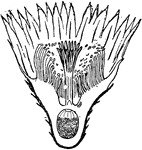
Echinocactus Flower
The stamens of the echinocactus flower are very numerous and are inserted on the petals of flower envelope…

Echinocactus Fruit
The fruit of echinocactus are very scaly. Some species of echinocactus are known as strawberry cacti.
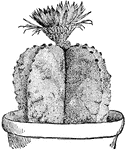
Echinocactus Myriostigma
Echinocactus myriostigma is native to Mexico. The flowers are large and pale yellow. The cactus is five…

Echinocactus Rectispinus
The echinocactus rectispinus cactus is round and cylindrical. The flowers are about one inch long and…

Echinocactus Whipplei
The echinocactus whipplei cactus grows three to five inches tall. The flower is greenish red. It is…

Echinocereus Chloranthus
Echinocereus chloranthus is native to Texas and New Mexico. The flowers are white and green.

Echinocereus Flower
Illustrated is an echinocereus flower showing the radiate stigma. The emerald green star of the flower…
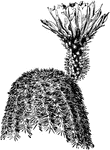
Echinocereus Rigidissimus
The common name of echinocereus rigidissimus is rainbow cactus. It is native to Arizona and New Mexico.
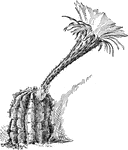
Echinopsis Gemmata
Echinopsis gemmata is native to south Brazil. The flowers are clear white with a pale greenish midline…

Epiphyllum
Illustrated is one of many hybrid epiphyllums. The flowers are usually white or yellowish.
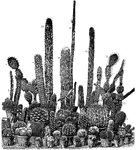
Group of Cacti
There are sixteen types of cacti pictures. Those varieties include opuntia, cereus, opuntia streptacantha,…
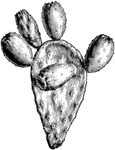
Branch of Indian Fig
Indian fig, the common name of optunia ficus-indica, has yellow flowers that bloom in May. The fruit…

Leuchtenbergia Principis
Illustrated is a leuchtenbergia principis showing the transformation from scales to petals.
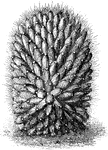
Mammillaria Dolichocentra
Mammillaria dolichocentra is a cactus with pale rose or reddish crimson flowers. The stem is six to…
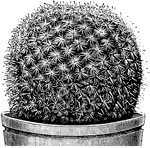
Mammillaria Haageana
The mammillaria haageana cactus has bright carmine rose flowers. The stem is bullet shaped when young…

Mammillaria Sanguinea
The mammillaria sanguinea cactus has dark red flowers. The stem is short and columnar. This cactus is…
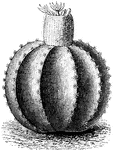
Melon Cactus
Melon cactus, or Turk's Cap, is the common name of melocactus communis. The flowers are rosy red.
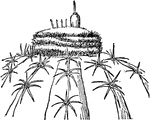
Melon Cactus
Illustrated is a melon cactus bearing fruits. The fruits of the melon cactus issue from the dense crown…

Seal of New Mexico
The Great Seal of the State of New Mexico, 1850. The seal pictures the American Bald Eagle and the Mexican…

Optunia Brachyarthra
Optunia brachyarthra is a variety of prickly pear. The flowers are very small. The prickles grow in…

Flowering Branch of Optunia Multiflora
Optunia multiflora is a variety of prickly pear. The flowers are yellow and bloom in summer. The branches…
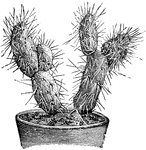
Optunia Platyacantha
Optunia platyacantha is a variety of prickly pear. This plant has a low branching stem. The spines have…

Optunia Rafinesquii
Optunia rafinesquii is a variety of prickly pear. The flowers often have a red center and numerous petals.…

Optunia Tuna
Optunia tuna is a variety of prickly pear. The flowers are reddish orange and bloom in July. There are…

Opuntia Basilaris
Opuntia basilaris is a variety of prickly pear with large, rose purple flowers. The flowers bloom in…

Opuntia Boliviana
Opuntia boliviana is a variety of prickly pear. The joints of the plant are about two inches long and…
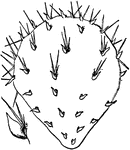
Opuntia Joint
Illustrated is an opuntia joint with leaves. The leaves are fleshy and cylindrical or awl shaped.

Skeleton of Opuntia Stem
Illustrated is a skeleton of an opuntia stem. These skeleton stems are sometimes made into walking-sticks.
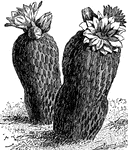
Pelecyphora Aselliformis
Illustrated is the extreme condensation of the plant body of pelecyphora aselliformis. The spines resemble…
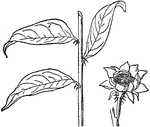
Pereskia Aculeata
The leaves of pereskia aculeata are large and perfectly developed, with feather veins. Pereskia belongs…
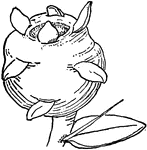
Pereskia Fruit
The pereskia fruit is apple shaped and bears a number of leaf-like bracts on the skin.

Pilocereus Brunnowii
Pilocereus brunnowii is a type of cactus. The stem is erect and cylindrical. There are about thirteen…

Pilocereus Dautwitzii
The pilocereus dautwitzii cactus as a bright green, oblong stem. Tufts of small white spines spread…
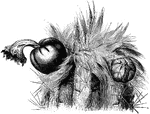
Pilocereus Houlletii
The flowers of pilocereus houlletii are violet with hints of red and yellow. The stem is strong and…

Seedling of Prickly Pear
Prickly pear or Indian fig is the common name of opuntia. Pictured is the seedling showing the mode…

Rhipsalis Cassytha
Illustrated are tips of rhipsalis cassytha. Rhipsalis plants have habits similar to mistletoe. It grows…
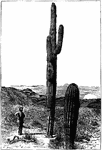
Saguaro
It is native to the Sonoran Desert in Arizona, the Mexican states of Sonora and Baja California, and…

Jesus Speaks to the Samaritan Woman at the Well
"and Jacob's well was there. Jesus therefore, being wearied with his journey, sat thus by the well.…
